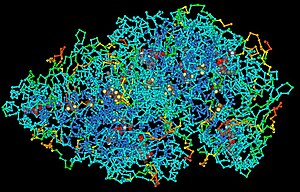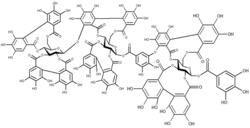Macromolecule

Amacromoleculeis a very largemoleculeimportant to biological processes, such as aproteinornucleic acid.It is composed of thousands ofcovalently bondedatoms.Many macromolecules arepolymersof smaller molecules calledmonomers.The most common macromolecules inbiochemistryarebiopolymers(nucleic acids,proteins,andcarbohydrates) and large non-polymeric molecules such aslipids,nanogelsandmacrocycles.[1]Synthetic fibers and experimental materials such ascarbon nanotubes[2][3]are also examples of macromolecules.
Definition[edit]
Macromolecule
Large moleculeA molecule of high relative molecular mass, the structure of which essentially
comprises the multiple repetition of units derived, actually or conceptually, from
molecules of low relative molecular mass.
- Notes
1. In many cases, especially for synthetic polymers, a molecule can be regarded
as having a high relative molecular mass if the addition or removal of one or a
few of the units has a negligible effect on the molecular properties. This statement
fails in the case of certain macromolecules for which the properties may be
critically dependent on fine details of the molecular structure.
2. If a part or the whole of the molecule fits into this definition, it may be described
as eithermacromolecularorpolymeric,or bypolymerused adjectivally.[4]
The termmacromolecule(macro-+molecule) was coined byNobel laureateHermann Staudingerin the 1920s, although his first relevant publication on this field only mentionshigh molecular compounds(in excess of 1,000 atoms).[5]At that time the termpolymer,as introduced byBerzeliusin 1832, had a different meaning from that of today: it simply was another form ofisomerismfor example withbenzeneandacetyleneand had little to do with size.[6]
Usage of the term to describe large molecules varies among the disciplines. For example, whilebiologyrefers to macromolecules as the four large molecules comprising living things, inchemistry,the term may refer to aggregates of two or more molecules held together byintermolecular forcesrather thancovalent bondsbut which do not readily dissociate.[7]
According to the standardIUPACdefinition, the termmacromoleculeas used in polymer science refers only to a single molecule. For example, a single polymeric molecule is appropriately described as a "macromolecule" or "polymer molecule" rather than a "polymer," which suggests asubstancecomposed of macromolecules.[8]
Because of their size, macromolecules are not conveniently described in terms ofstoichiometryalone. The structure of simple macromolecules, such as homopolymers, may be described in terms of the individual monomer subunit and totalmolecular mass.Complicated biomacromolecules, on the other hand, require multi-faceted structural description such as the hierarchy of structures used to describeproteins.InBritish English,the word "macromolecule" tends to be called "high polymer".
Properties[edit]
This sectionneeds additional citations forverification.(May 2013) |
Macromolecules often have unusual physical properties that do not occur for smaller molecules.[how?]
Another common macromolecular property that does not characterize smaller molecules is their relative insolubility in water and similarsolvents,instead formingcolloids.Many requiresaltsor particularionsto dissolve in water. Similarly, many proteins willdenatureif the solute concentration of their solution is too high or too low.
High concentrations of macromolecules in a solution can alter theratesandequilibrium constantsof the reactions of other macromolecules, through an effect known asmacromolecular crowding.[9]This comes from macromoleculesexcludingother molecules from a large part of the volume of the solution, thereby increasing theeffective concentrationsof these molecules.
Linear biopolymers[edit]
Allliving organismsare dependent on three essentialbiopolymersfor their biological functions:DNA,RNAandproteins.[10]Each of these molecules is required for life since each plays a distinct, indispensable role in thecell.[11]The simple summary is thatDNA makes RNA, and then RNA makes proteins.
DNA, RNA, and proteins all consist of a repeating structure of related building blocks (nucleotidesin the case of DNA and RNA,amino acidsin the case of proteins). In general, they are all unbranched polymers, and so can be represented in the form of a string. Indeed, they can be viewed as a string of beads, with each bead representing a single nucleotide or amino acid monomer linked together throughcovalent chemical bondsinto a very long chain.
In most cases, the monomers within the chain have a strong propensity to interact with other amino acids or nucleotides. In DNA and RNA, this can take the form ofWatson–Crick base pairs(G–C and A–T or A–U), although many more complicated interactions can and do occur.
Structural features[edit]
| DNA | RNA | Proteins | |
|---|---|---|---|
| Encodes genetic information | Yes | Yes | No |
| Catalyzes biological reactions | No | Yes | Yes |
| Building blocks (type) | Nucleotides | Nucleotides | Amino acids |
| Building blocks (number) | 4 | 4 | 20 |
| Strandedness | Double | Single | |
| Structure | Double helix | Complex | Complex |
| Stability to degradation | High | Variable | Variable |
| Repair systems | Yes | No | No |
Because of the double-stranded nature of DNA, essentially all of the nucleotides take the form ofWatson–Crick base pairsbetween nucleotides on the two complementary strands of thedouble helix.
In contrast, both RNA and proteins are normally single-stranded. Therefore, they are not constrained by the regular geometry of the DNA double helix, and so fold into complexthree-dimensional shapesdependent on their sequence. These different shapes are responsible for many of the common properties of RNA and proteins, including the formation of specificbinding pockets,and the ability to catalyse biochemical reactions.
DNA is optimised for encoding information[edit]
DNAis an information storage macromolecule that encodes the complete set ofinstructions(thegenome) that are required to assemble, maintain, and reproduce every living organism.[12]
DNA and RNA are both capable of encoding genetic information, because there are biochemical mechanisms which read the information coded within a DNA or RNA sequence and use it to generate a specified protein. On the other hand, the sequence information of a protein molecule is not used by cells to functionally encode genetic information.[1]: 5
DNA has three primary attributes that allow it to be far better than RNA at encoding genetic information. First, it is normally double-stranded, so that there are a minimum of two copies of the information encoding each gene in every cell. Second, DNA has a much greater stability against breakdown than does RNA, an attribute primarily associated with the absence of the 2'-hydroxyl group within every nucleotide of DNA. Third, highly sophisticated DNA surveillance and repair systems are present which monitor damage to the DNA andrepairthe sequence when necessary. Analogous systems have not evolved for repairing damaged RNA molecules. Consequently, chromosomes can contain many billions of atoms, arranged in a specific chemical structure.
Proteins are optimised for catalysis[edit]
Proteins are functional macromolecules responsible forcatalysingthebiochemical reactionsthat sustain life.[1]: 3 Proteins carry out all functions of an organism, for example photosynthesis, neural function, vision, and movement.[13]
The single-stranded nature of protein molecules, together with their composition of 20 or more different amino acid building blocks, allows them to fold in to a vast number of different three-dimensional shapes, while providing binding pockets through which they can specifically interact with all manner of molecules. In addition, the chemical diversity of the different amino acids, together with different chemical environments afforded by local 3D structure, enables many proteins to act asenzymes,catalyzing a wide range of specific biochemical transformations within cells. In addition, proteins have evolved the ability to bind a wide range ofcofactorsandcoenzymes,smaller molecules that can endow the protein with specific activities beyond those associated with the polypeptide chain alone.
RNA is multifunctional[edit]
RNAis multifunctional, its primary function is toencode proteins,according to the instructions within a cell's DNA.[1]: 5 They control and regulate many aspects of protein synthesis ineukaryotes.
RNA encodes genetic information that can betranslatedinto the amino acid sequence of proteins, as evidenced by the messenger RNA molecules present within every cell, and the RNA genomes of a large number of viruses. The single-stranded nature of RNA, together with tendency for rapid breakdown and a lack of repair systems means that RNA is not so well suited for the long-term storage of genetic information as is DNA.
In addition, RNA is a single-stranded polymer that can, like proteins, fold into a very large number of three-dimensional structures. Some of these structures provide binding sites for other molecules and chemically active centers that can catalyze specific chemical reactions on those bound molecules. The limited number of different building blocks of RNA (4 nucleotides vs >20 amino acids in proteins), together with their lack of chemical diversity, results in catalytic RNA (ribozymes) being generally less-effective catalysts than proteins for most biological reactions.
The Major Macromolecules:
| Macromolecule
(Polymer) |
Building Block
(Monomer) |
Bonds that Join them |
|---|---|---|
| Proteins | Amino acids | Peptide |
| Nucleic acids | Phosphodiester | |
| DNA | Nucleotides (a phosphate, ribose, and a base- adenine, guanine, thymine, or cytosine) | |
| RNA | Nucleotides (a phosphate, ribose, and a base- adenine, guanine, uracil, or cytosine) | |
| Polysaccharides | Monosaccharides | Glycosidic |
| Lipids | unlike the other macromolecules, lipids are not defined by chemical Structure. Lipids are any organic nonpolar molecule. | Some lipids are held together by ester bonds; some are huge aggregates of small molecules held together by hydrophobic interactions. |
| Carbohydrates | carbon, hydrogen, and oxygen | |
| Major protein Complexes? |
Branched biopolymers[edit]

Carbohydratemacromolecules (polysaccharides) are formed from polymers ofmonosaccharides.[1]: 11 Because monosaccharides have multiplefunctional groups,polysaccharides can form linear polymers (e.g.cellulose) or complex branched structures (e.g.glycogen). Polysaccharides perform numerous roles in living organisms, acting as energy stores (e.g.starch) and as structural components (e.g.chitinin arthropods and fungi). Many carbohydrates contain modified monosaccharide units that have had functional groups replaced or removed.
Polyphenolsconsist of a branched structure of multiplephenolicsubunits. They can perform structural roles (e.g.lignin) as well as roles assecondary metabolitesinvolved insignalling,pigmentationanddefense.
Synthetic macromolecules[edit]

Some examples of macromolecules are synthetic polymers (plastics,synthetic fibers,andsynthetic rubber),graphene,andcarbon nanotubes.Polymers may be prepared from inorganic matter as well as for instance ininorganic polymersandgeopolymers.The incorporation of inorganic elements enables the tunability of properties and/or responsive behavior as for instance insmart inorganic polymers.
See also[edit]
References[edit]
- ^abcdeStryer L, Berg JM, Tymoczko JL (2002).Biochemistry(5th ed.). San Francisco:W.H. Freeman.ISBN978-0-7167-4955-4.
- ^Life cycle of a plastic productArchived2010-03-17 at theWayback Machine.Americanchemistry.com. Retrieved on 2011-07-01.
- ^Gullapalli, S.; Wong, M.S. (2011)."Nanotechnology: A Guide to Nano-Objects"(PDF).Chemical Engineering Progress.107(5): 28–32. Archived fromthe original(PDF)on 2012-08-13.Retrieved2015-06-28.
- ^Jenkins, A. D; Kratochvíl, P; Stepto, R. F. T; Suter, U. W (1996)."Glossary of basic terms in polymer science (IUPAC Recommendations 1996)"(PDF).Pure and Applied Chemistry.68(12): 2287–2311.doi:10.1351/pac199668122287.S2CID98774337.Archived fromthe original(PDF)on 2016-03-04.Retrieved2013-07-27.
- ^Staudinger, H.; Fritschi, J. (1922)."Über Isopren und Kautschuk. 5. Mitteilung. Über die Hydrierung des Kautschuks und über seine Konstitution".Helvetica Chimica Acta.5(5): 785.doi:10.1002/hlca.19220050517.
- ^Jensen, William B.(2008). "The Origin of the Polymer Concept".Journal of Chemical Education.85(5): 624.Bibcode:2008JChEd..85..624J.doi:10.1021/ed085p624.
- ^van Holde, K.E. (1998)Principles of Physical BiochemistryPrentice Hall: New Jersey,ISBN0-13-720459-0
- ^Jenkins, A. D.; Kratochvíl, P.; Stepto, R. F. T.; Suter, U. W. (1996)."Glossary of Basic Terms in Polymer Science"(PDF).Pure and Applied Chemistry.68(12): 2287.doi:10.1351/pac199668122287.S2CID98774337.Archived fromthe original(PDF)on 2007-02-23.
- ^Minton AP (2006)."How can biochemical reactions within cells differ from those in test tubes?".J. Cell Sci.119(Pt 14): 2863–9.doi:10.1242/jcs.03063.PMID16825427.
- ^Berg, Jeremy Mark; Tymoczko, John L.; Stryer, Lubert (2010).Biochemistry, 7th ed. (Biochemistry (Berg)).W.H. Freeman & Company.ISBN978-1-4292-2936-4.Fifth edition available online through the NCBI Bookshelf:link
- ^Walter, Peter; Alberts, Bruce; Johnson, Alexander S.; Lewis, Julian; Raff, Martin C.; Roberts, Keith (2008).Molecular Biology of the Cell (5th edition, Extended version).New York:Garland Science.ISBN978-0-8153-4111-6..Fourth edition is available online through the NCBI Bookshelf:link
- ^Golnick, Larry; Wheelis, Mark. (1991-08-14).The Cartoon Guide to Genetics.Collins Reference.ISBN978-0-06-273099-2.
- ^Takemura, Masaharu (2009).The Manga Guide to Molecular Biology.No Starch Press.ISBN978-1-59327-202-9.
- ^Roland E. Bauer; Volker Enkelmann; Uwe M. Wiesler; Alexander J. Berresheim; Klaus Müllen (2002). "Single-Crystal Structures of Polyphenylene Dendrimers".Chemistry: A European Journal.8(17): 3858–3864.doi:10.1002/1521-3765(20020902)8:17<3858::AID-CHEM3858>3.0.CO;2-5.PMID12203280.
External links[edit]
- Synopsis of Chapter 5, Campbell & Reece, 2002
- Lecture notes on the structure and function of macromolecules
- Several (free) introductory macromolecule related internet-based coursesArchived2011-07-18 at theWayback Machine
- Giant Molecules!by Ulysses Magee,ISSA ReviewWinter 2002–2003,ISSN1540-9864.Cached HTML version of a missing PDF file. Retrieved March 10, 2010. The article is based on the book,Inventing Polymer Science: Staudinger, Carothers, and the Emergence of Macromolecular Chemistryby Yasu Furukawa.
